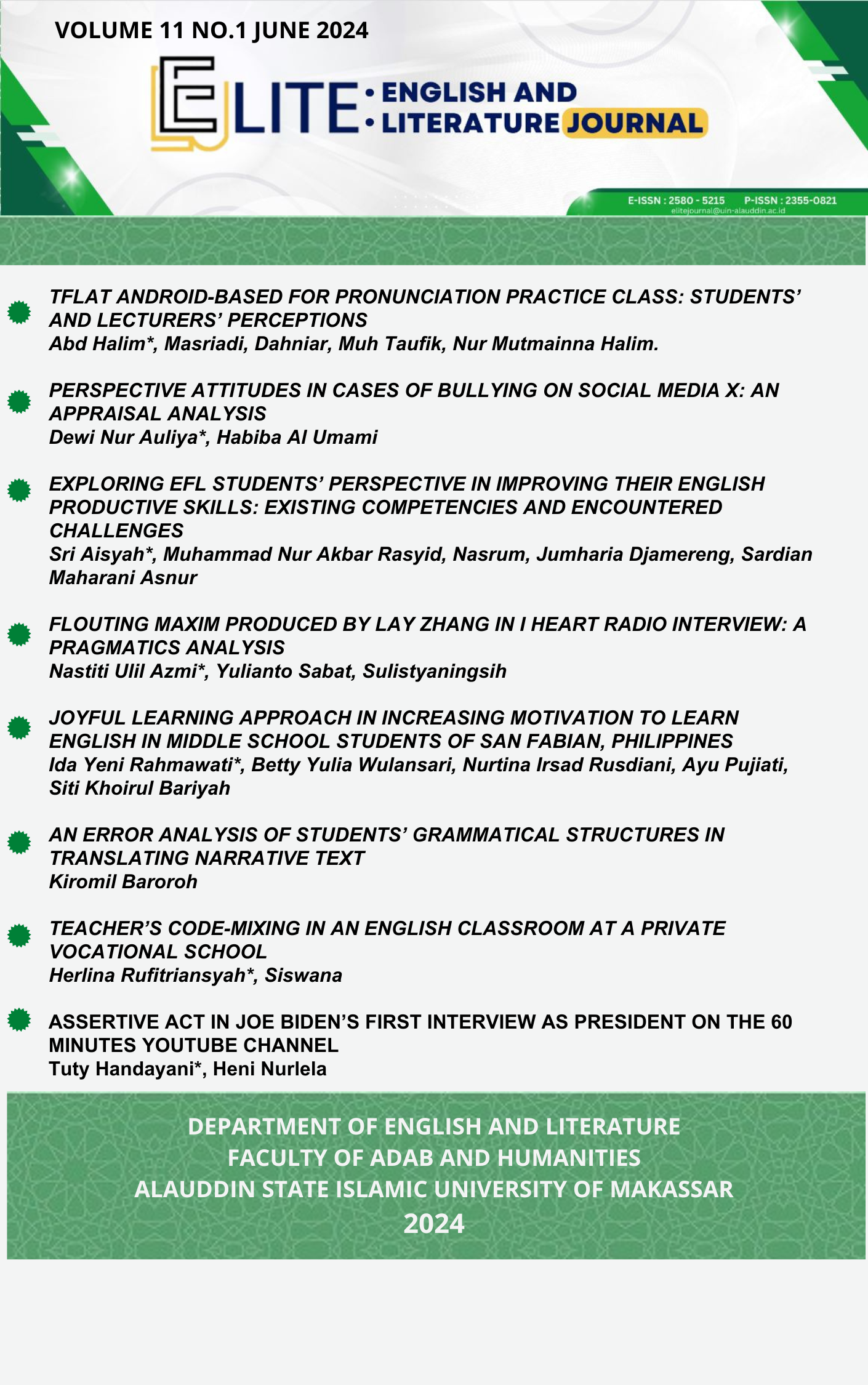Bahasa inggris
Abstrak
Penelitian ini bertujuan untuk menganalisis jenis campur kode yang terjadi oleh guru bahasa Inggris ketika mengajar pelajaran bahasa Inggris, dan mengetahui alasan penggunaan campur kode tersebut. Penelitian ini menggunakan jenis penelitian kualitatif deskriptif. Objek penelitian ini adalah satu orang guru bahasa Inggris di SMK Swasta di Bogor. Proses pengumpulan data, peneliti merekam audio suara guru ketika mengajar di kelas dan juga ketika melakukan wawancara. Teknik analisis data menggunakan teori Muysken. Dalam penelitian ini, ditemukan bahwa terdapat tiga jenis campur kode yang digunakan oleh guru ketika mengajar, yaitu jenis penyisipan, pergantian, dan kesesuaian leksikal. Penggunaan jenis penyisipan sekitar 55%, kemudian pergantian 44%, dan kongruen leksikal 1%, dari 158 total ujaran yang diperoleh. Hasil yang ditemukan dalam penelitian ini adalah guru lebih sering menggunakan campur kode jenis insersi ketika mengajar bahasa Inggris. Kemudian tiga alasan penggunaan campur kode oleh guru, yaitu karena latar belakang sekolah jurusan, untuk pemahaman siswa terhadap materi, dan adanya keterbatasan pemahaman siswa dalam berbahasa Inggris.
##plugins.generic.usageStats.downloads##
Referensi
Abd Rahman, S. N., Samad, A. A., & Bakar, N. A. (2020). Exploring learners’ perception on improving their willingness to communicate in English through experiential learning among undergraduate students. Universal Journal of Educational Research, 8(1 A), 62–69. https://doi.org/10.13189/ujer.2020.081309
Abidasaria, E., & Lestaria, A. (2020). Language code-mixing and its underlying reason of usefor a better teaching planning. Pendidikan Profesi Guru, 1(1), 1–11.
Andas, N. H. (2020). Journal of Linguistics and English Teaching Studies. Journal of Linguistics and English Teaching Studies, 25–43.
Asrifan, A. (2023). Code Mixing and Code Switching in the EFL Classroom Interaction Code Mixing And Code Switching In The Efl Classroom Interaction. (January).
Fanani, A., & Ma’u, J. A. R. Z. (2018). Code switching and code mixing in English learning process. LingTera, 5(1), 68–77. https://doi.org/10.21831/lt.v5i1.14438
Fitria, T. N. (2022). Code Mixing Used by English Lecturers in English Language Teaching ( ELT ) for Non-EFL Students Campur Kode yang Digunakan oleh Dosen Bahasa Inggris dalam Pengajaran. Jurnal Pendidikan Bahasa Dan Sastra, 22, 209–222.
Hiver, P., Al-Hoorie, A. H., Vitta, J. P., & Wu, J. (2024). Engagement in language learning: A systematic review of 20 years of research methods and definitions. Language Teaching Research, 28(1), 201–230. https://doi.org/10.1177/13621688211001289
Hoffmann, C. (1991). An Introduction to Bilingualism. New York: Longman Group.
Imanudin, F. J., & Astutik, Y. (2023a). Code Mixing in Online English Classes: A Qualitative Analysis of Teacher-Student Communication at Junior High School Level. Indonesian Journal of Education Methods Development, 21(3), 1–14. https://doi.org/10.21070/ijemd.v21i3.759
Imanudin, F. J., & Astutik, Y. (2023b). Code Mixing in Online English Classes: A Qualitative Analysis of Teacher-Student Communication at Junior High School Level. Indonesian Journal of Innovation Studies, 13(1), 1–12.
Kahfi, A. (2018). Code Mixing Used By the Teachersin Teaching English At Smkt Somba Opu. Ty of Teacher Training and Education Makassar M, 1.102.
Melansari, N., Wahyuni, A. B., Adu, B., & Narni. (2023). Code Mixing Used by the Teacher in Teaching English at SMP Negeri 14 Baubau. International Journal of Education, Language, Literature, Arts, Culture, and Social Humanities, 1(1), 14–28.
Muysken. (2000a). Bilingual speech: A typology of code-mixing. Cambridge University Press.
Muysken, P. (2000b). Code-mixing, bilingual speech and language change. Bilingual Speech_ A Typology of Code-Mixing, (1995), 250–262.
Novianti, R., & Said, M. (2021). The Use of Code-Switching and Code-Mixing in English Teaching-Learning Process. Deiksis, 13(1), 82. https://doi.org/10.30998/deiksis.v13i1.8491
Nurpiana, Z., & Fithriani, R. (2023). Indonesian EFL Teachers’ Use of Code Mixing in Classroom Interactions. Journal of Vocational Education Studies, 6(1), 25–39. https://doi.org/10.12928/joves.v6i1.8049
Peter, R., & Simatupang, M. S. (2022). Keberagaman Bahasa Dan Budaya Sebagai Kekayaan Bangsa Indonesia. Dialektika: Jurnal Bahasa, Sastra Dan Budaya, 9(1), 96–105. https://doi.org/10.33541/dia.v9i1.4028
Purnamasari, N. M. G., Putra, I. N. A. J., & Suwastini, N. K. A. (2018). A Desccriptive Study on the Use of Code Mixing by the English Teacher at SMAN Bali Mandara in the Academic Year 2014/2015. Lingua Scientia, 23(2), 1. https://doi.org/10.23887/ls.v23i2.16070
Rahmawati, L., Sholeha, M., & Rizka, H. (2022). Code-Mixing in WhatsApp Group Discussions of Online English Classes. Journal of English and Education (JEE), 8(2), 73–80. https://doi.org/10.20885/jee.v8i2.24374
Repka, R. (2020). Towards A Definition Of Language. In Philologia (Vol. 1).
Riantini, A., & Kadek, N. (2023). Type of Code Mixing Found in Podcast Md Entertainment By Frederika Cull on Podcast Youtube Channel. LINGUISTIK : Jurnal Bahasa Dan Sastra, 8(4), 612. https://doi.org/10.31604/linguistik.v8i4.612-618
Rizki Lukitasari, D. (2020). Postcolonial Theories On Promoting World Englishes In Efl/Esl Speaking Class. Elite : English and Literature Journal, 7, 13–22. https://doi.org/https://doi.org/10.24252/elite.v7i1a2
Sa’diyah. (2020). Metode Pembelajaran Aktif Dan Kreatif Pada Madrasah Diniyah Takmiliyah Di Kota Bogor. Edukasi Islami: Jurnal Pendidikan Islam, 9(01), 73–74.
Sari, A. W. (2016). Pentingnya Keterampilan Mendengar Dalam Menciptakan Komunikasi Yang Efektif. Jurnal EduTech, 2(1), 1–10. Retrieved from http://jurnal.umsu.ac.id/index.php/edutech/article/view/572
Thambu, N., Prayitno, H. J., & Zakaria, G. A. N. (2021). Incorporating Active Learning into Moral Education to Develop Multiple Intelligences: A Qualitative Approach. Indonesian Journal on Learning and Advanced Education (IJOLAE), 3(1), 17–29. https://doi.org/10.23917/ijolae.v3i1.10064
Vitriya, N., Luthfiyati, D., & Widyaiswara, T. (2022). Teachers’ code mixing and code switching: Insights on language barriers in EFL classroom. Jurnal Penelitian Humaniora, 27. https://doi.org/10.21831/hum.v27i2.52446
Widianingsih, E. (2023). Teacher ’ S Code -Mixing To Teach Writing Of Narrative Text In 2013 Curriculum Framework ( A Case Study at the Tenth Grade of a Vocational High School in Ciamis ) ABSTRACT This study investigated teacher ’ s code -mixing to teach writing of narrative text. Journal of Vocational Education Studies, 6(1), 25–39.
Widyasari, F. E. (2016). Pembelajaran Bahasa Inggris dengan Menggunakan Metode Multiple Intelligences: Studi Kasus di Sekolah Internasional. Jurnal Edutama, 31–46.
##submission.copyrightStatement##
##submission.license.cc.by-nc-sa4.footer##Once an article was published in the journal, the author(s) are:
granted to the journal right licensed under Creative Commons License Attribution that allows others to share the work with an acknowledgement of the work's authorship.
permitted to publish their work online in third parties as it can lead wider dissemination of the work.
continue to be the copyright owner and allow the journal to publish the article with the CC BY-NC-SA 4.0 license
receiving a DOI (Digital Object Identifier) of the work.


